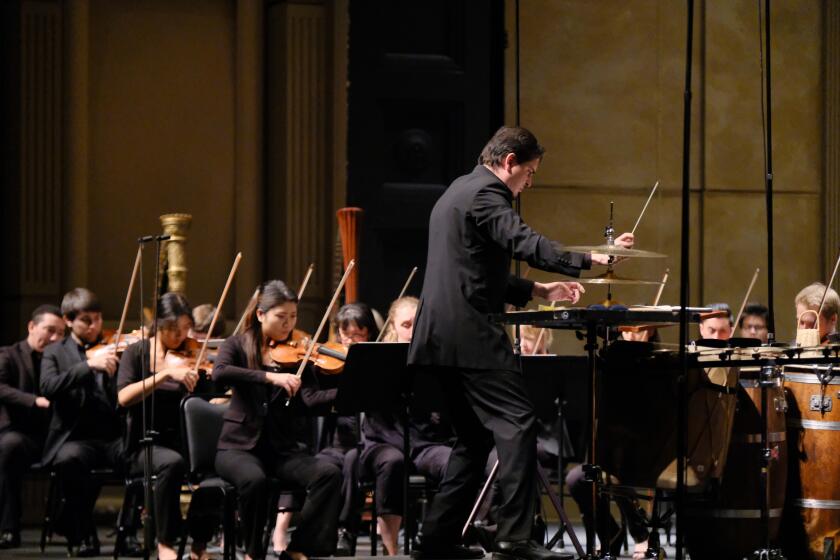ART REVIEW : Taking a Crash Course in the ‘Spirit of Fluxus’ : A large, ambitious exhibition at Santa Barbara Museum of Art lays out the terrain for the raucous movement that began in ’61.
Ben Vautier’s sculpture “Ben’s Museum” is a stark encapsulation of the wittily insightful rigor of which Fluxus art of the 1960s and 1970s was capable. In its way, though, it also exposes a certain flabbiness within the movement’s core.
The sculpture, which turns up near the end of the large and ambitious exhibition “In the Spirit of Fluxus,” newly opened at the Santa Barbara Museum of Art, is composed of a large wooden packing crate--the kind in which paintings are typically shipped or stored. The crate stands upright and is partly opened, like a book.
Displayed inside are a variety of objects--small paintings, toys, assemblage sculptures--many accompanied by Vautier’s familiar, graffiti-like ruminations on art, modern absurdity and the yearning for a kind of primitive spirituality. Accompanying instructions say that the open crate should be closed slightly as time goes by--10 centimeters a year, to be precise, until finally the crate is shut tight and packed off to permanent storage.
Overall, the almost ceremonial process of slow closure is an eloquent metaphor for the inevitable passage of contemporary culture into history, and for the distinctly modern transmutation of vibrant life into the sorted, boxed and catalogued archeology of the museum. What’s flimsy about the piece, though, is the unmemorable stuff Vautier packed inside.
Looking at the cornball knickknacks, which are meant to stand for traditional works of art, you can’t help but eagerly anticipate the moment when the crate is indeed tightly shut. Then, the unviewable objects secreted inside will be transformed into mysterious talismans that, paradoxically, will at last be endowed with something more than their present condition of matter-of-fact curiosity. As in the alchemist’s dream, lead will have turned into gold.
That Vautier’s crate is a packing case specifically for paintings is itself an acerbic acknowledgment of the traditional hierarchy within the modern commercial system of art, wherein painting rules. Fluxus artists, wanting to disrupt the entrenched routines of art and life, used guerrilla theater, electronic concerts, mass-produced broadsheets and the ubiquitous motif of sculpture-in-a-box, replacing commonly sober considerations of artistic style with a temperament of jokey anarchism.
The Santa Barbara show, organized last year for the Walker Art Center in Minneapolis, does a good job of laying out the terrain of the raucous movement, which began in Germany in 1961 and quickly spread throughout Northern Europe, the United States (especially New York) and Japan. (The mail helped the international spread, as a genre of postal art flourished.) If you want a crash course in Fluxus, you couldn’t get a better one than this.
George Maciunas, the reigning godfather of Fluxus, is well represented, as is the work of such other influential artists as Nam June Paik, George Brecht, Joseph Beuys, Claes Oldenburg and Robert Watts. There are also lesser lights, such as Ken Friedman and Yoko Ono.
There are some surprises, too. If Beuys and Oldenburg were only briefly affiliated with Fluxus, who knew that Per Kirkeby, a prominent abstract painter of the past dozen years, likewise made Fluxus objects earlier in his career?
Much of the show is drawn from the sprawling and important Gilbert and Lila Silverman collection in Detroit, which was begun in 1978, the year of Maciunas’ untimely death from cancer and pretty much the signal of the final demise (long overdue) of Fluxus as a lively movement. A big chunk of the Silverman collection has been seen in Southern California before--in 1983, at Caltech’s former Baxter Art Gallery--and it has been the subject of four substantive publications, the most impressive being 1988’s 600-page “Fluxus Codex.”
So, Fluxus is not exactly suffering from obscurity or neglect, although you do get an aggressive whiff of evangelical fervor from the show. It’s there in much of the art, too.
It’s easy to see why. The anarchistic spirit of Fluxus is akin to the irrational provocations of Dada, which exploded in Europe during World War I, very much in heated response to the unprecedented, even unfathomable carnage of the Great War’s brutal conflict. Fluxus had its unspeakable war, too: The American misadventure in Vietnam was catalytic for many artists, in both the United States and Europe.
This important social platform for a many-sided assault on traditional aesthetics mixes with distinctly personal motives, as in Vautier’s frank admission that he lived inside a storefront for the duration of a 1962 Fluxus exhibition simply because he yearned to be famous as an artist. (A reconstruction of the storefront is at the entrance to the exhibition.) As the era passes, though, the social matrix inevitably fades from view, while the sense of self-indulgence remains intact.
You have to work at keeping the conflicted period of the 1960s fully in mind, so as not to succumb to a dreamy nostalgia for Fluxus purity. Carolee Schneeman helpfully bursts any such bubbles, with a case full of pointed notations on the commonness of misogyny among Fluxus artists.
One big difference between Dada and Fluxus is the degree to which the behemoth of mass culture loomed large in the 1960s--and still does. For if the collision between mass production and the individual provided much of the insouciant energy for Fluxus, which promoted mail-order art as a way to undercut the preciousness of unique paintings, so the lure of mass entertainment is inescapable in the exhibition.
“I’d say it’s not really art at all,” a museum trustee brightly declared to me while perusing the show. “But it sure is fun!”
* Santa Barbara Museum of Art, 1130 State St., (805) 963-4364, through Oct. 16. Closed Mondays.
More to Read
The biggest entertainment stories
Get our big stories about Hollywood, film, television, music, arts, culture and more right in your inbox as soon as they publish.
You may occasionally receive promotional content from the Los Angeles Times.







